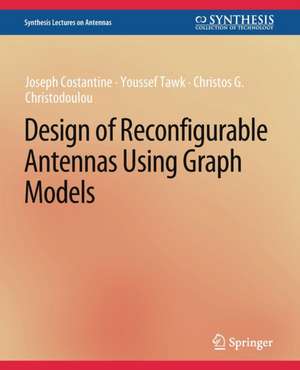Design of Reconfigurable Antennas Using Graph Models: Synthesis Lectures on Antennas
Autor Joseph Costantine, Youssef Tawk, Christos Christodoulouen Limba Engleză Paperback – 12 aug 2013
Preț: 348.77 lei
Nou
Puncte Express: 523
Preț estimativ în valută:
66.74€ • 71.37$ • 55.64£
66.74€ • 71.37$ • 55.64£
Carte tipărită la comandă
Livrare economică 18 aprilie-02 mai
Preluare comenzi: 021 569.72.76
Specificații
ISBN-13: 9783031004124
ISBN-10: 3031004124
Ilustrații: XI, 136 p.
Dimensiuni: 191 x 235 mm
Greutate: 0.27 kg
Editura: Springer International Publishing
Colecția Springer
Seria Synthesis Lectures on Antennas
Locul publicării:Cham, Switzerland
ISBN-10: 3031004124
Ilustrații: XI, 136 p.
Dimensiuni: 191 x 235 mm
Greutate: 0.27 kg
Editura: Springer International Publishing
Colecția Springer
Seria Synthesis Lectures on Antennas
Locul publicării:Cham, Switzerland
Cuprins
Introduction to Reconfigurable Antennas.- Graph Modeling Reconfigurable Antennas.- Reconfigurable Antenna Design Using Graph Models.- Redundancy Reduction in Reconfigurable Antenna Structures.- Analyzing the Complexity and Reliability of Switch-Frequency Reconfigurable Antennas Using Graph Models.- Complexity Versus Reliability in Arrays of Reconfigurable Antennas.- Detection and Correction of Switch Failures in Switch Reconfigurable Antenna Arrays.- Conclusion.- Bibliography.- Authors' Biographies.
Notă biografică
Joseph Costantine received his Ph.D. degree from the University of New Mexico in 2009 where he also completed a post-doc fellowship in July 2010. Dr. Costantine has a Masters in Computer and Communications Engineering from the American University of Beirut in 2006. His bachelor’s degree is in Electrical, Electronics, Computer, and Communications Engineering from the second branch of the Faculty of Engineering in the Lebanese University in 2004. He is the recipient of many awards including the summer faculty fellowship from the space vehicles directorate in Albuquerque, NM, for three consecutive years. He has published many research papers and has several patents. His major research interests reside in reconfigurable antennas for wireless communication systems, cognitive radio, antennas for biomedical applications, and deployable antennas for small satellitesYoussef Tawk received the Ph.D. degree from the University of New Mexico in 2011 where he also completed a post-doc fellowship in August 2012. Dr. Tawk has a Master’s degree in Electrical and Computer Engineering from the American University of Beirut in 2008. His bachelor’s degree in Computer and Communication Engineering was received with highest distinction in 2006 from Notre Dame University, Louaize, Lebanon. He received many awards and honors throughout his studies. He has published several journal and conference papers and has several issued patents. His research interests include reconfigurable antenna systems, cognitive radio, radio-frequency (RF) electronic design, photonics, and millimeter-wave technologyChristos G. Christodoulou received his Ph.D. degree in Electrical Engineering from North Carolina State University in 1985. He served as a faculty member in the University of Central Florida, Orlando, from 1985 to 1998. In 1999, he joined the faculty of the Electrical and Computer Engineering Department of the University of New Mexico, where he served as the Chair of the Department from 1999 to2005. He is a Fellow member of IEEE and a member of Commission B of URSI. Currently he is the director for COSMIAC (Configurable Space Microsystems Innovations & Applications Center at UNM). He is the recipient of the 2010 IEEE John Krauss Antenna Award, the Lawton-Ellis Award, and the Gardner Zemke Professorship at the University of New Mexico. He has published about 400 papers in journals and conferences, has 13 book chapters, and has co- 136 AUTHORS’ BIOGRAPHIES authored five books. His research interests are in the areas of modeling of electromagnetic systems, adaptive array antennas, high power microwave antennas, reconfigurable antenna systems, cognitive radio, and smart RF/photonics.











